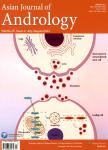A possible relationship between serum sex hormones and benign prostatic hyperplasia/Iower urinary tract symptoms in men who underwent transurethral prostate resection
A possible relationship between serum sex hormones and benign prostatic hyperplasia/Iower urinary tract symptoms in men who underwent transurethral prostate resection作者机构:Department of Urology Xinhua Hospital School of Medicine Shanghai Jiao Tong University Shanghai 200092 China Department of Gynecology Xinhua Hospital School of Medicine Shanghai Jiao Tong University Shanghai 200092 China Department of Assisted Reproduction Medicine International Peace Maternity and Child Health Hospital School of Medicine Shanghai Jiao Tong University Shanghai 200030 China
出 版 物:《Asian Journal of Andrology》 (亚洲男性学杂志(英文版))
年 卷 期:2017年第19卷第2期
页 面:230-233页
核心收录:
学科分类:10[医学]
基 金:Shanghai Municipal Natural Science Foundation 国家自然科学基金
主 题:aging benign prostatic hyperplasia lower urinary tract symptoms sex hormones testosterone
摘 要:In this study, we examined the relationship between sex hormone levels and lower urinary tract symptoms (LUTS) in men with benign prostatic hyperplasia (BPH) who underwent transurethral surgery. The study was conducted in 158 patients who came to our hospital for surgery. Clinical conditions were assessed by body mass index (BMI), digital rectal examination, International Prostate Symptom Score (IPSS) and transrectal ultrasound (TRUS). The levels of sex hormones (including total testosterone (TT), estradiol (E2), progesterone (P), luteinizing hormone (LH), follicle-stimulating hormone (FSH) and prolactin (PRL)) and prostate-specific antigen (PSA) were reviewed. Correlations were determined through statistical analysis. The mean age was 72.06 _+ 8.68 years. The total IPSS was significantly associated with the TT level (r = -0.21, P = 0.01). Other sex hormone levels were not correlated with total IPSS. However, some ratios such as E2/TT (r = 0.23, P = 0o00) and FSH/LH (r = -0.17, P = 0.04) were associated with total IPSS. Further analysis showed that the nocturia was associated with age (r = 0.16, P = 0.04), BMI (r = 0.21, P = 0.01), and TT (r = -0.19, P = 0.02). Moreover, we divided the patients into two subgroups based on IPSS severity (〈20 or 〉20). The mean TT level was in the normal range, but it was significantly related to the presence of severe LUTS. In summary, our study has shown that the severity of LUTS is associated with TT, EJTT and FSH/LH in men who underwent prostate surgery. Increasing nocturia was observed in lower testosterone patients. Additional larger studies are needed to elucidate the potential mechanisms.



